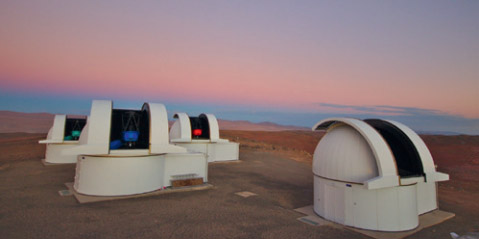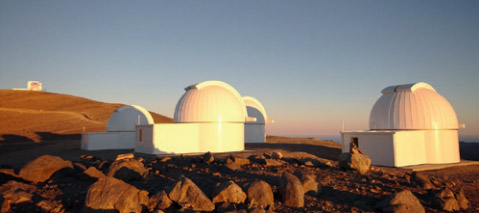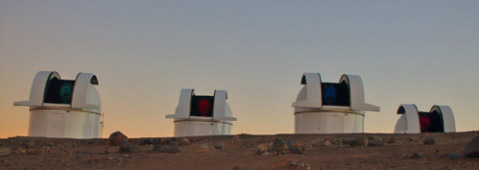Resources
 Part of the Oxford Instruments Group
Part of the Oxford Instruments Group
Expand
Collapse
 Part of the Oxford Instruments Group
Part of the Oxford Instruments Group
On January first, after only 2 years of construction in northern Chile, the SPECULOOS Southern Observatory started its fully robotic survey operations. The observatory is the core facility of a new exoplanet search called SPECULOOS, which stands for “Search for habitable Planets EClipsing Ultra-cOOl Stars”. It aims for nothing less than to detect rocky and temperate planets well-suited for the detection of chemical signatures of life in their atmospheres. This ambitious goal is only made possible by the combination of modern astronomical equipment, efficient detector technology, and one of the best astronomical sites in the world.
Not only philosophers raise this fundamental question, but it is more and more subject to scientific research. How does such Life look like on another world, and what are the requirements for sustaining a stable biosphere? Given the detection of thousands of exoplanets in the past twenty years, astronomers are not only searching for a second earth, but develop new strategies to explore fundamental physical properties from their orbital motion to their atmospheres. Therefore, we narrow the parameters available for possible life even on planets that orbit quite different stars than our sun.
The most successful method to find exoplanets today is the transit-method. Likewise, a transit of venus or mercury in front of our sun, each exoplanet, that moves in front of its star will block a part of the stellar light. This causes a slight dimming of the star light, which we call a transit and can be measured here on earth. This dimming is directly proportional to the size of the planet with respect to its star. That means the smaller the star, the larger is the proportion of the star, which is blocked from its transiting planet. In contrary, if we focus on relatively small stars, we also can detect small planets of the size of our earth or even below with ground-based telescopes.
Ultra-cool dwarf stars (UCDs) are the smallest stars of spectral type M6 and later, reaching well into the zone of Brown dwarfs. Those objects exhibit less than 0.1% of the luminosity of our Sun, and thus their habitable zone, where we call a planet to be temperate like our earth, is as close as 1% the distance of our earth to the sun. Given Kepler’s third law, one year on such close in planets would only last a couple of days.
In short, since UCDs are as small as Jupiter, we can detect the transits of small, rocky planets in their habitable zone with a ground-based survey. Those planets will allow us for the first time to study a probable place for Life outside of our solar system.
SPECULOOS is a dedicated survey lasting about ten years, that will allow us to observe each nearby UCD long enough to detect all transiting planets down to Martian size in their habitable zone. ESO’s Paranal observatory offers perfect photometric conditions (285 photometric nights per year) with very low humidity (< 4mm precipitable water vapor in 80% of the nights), as well as the necessary infra-structure to host a robotic observatory.

Figure 1: The four telescopes of the SPECULOOS Southern Observatory, ready for the night
Next to the NGTS observatory is the SPECULOOS Southern Observatory (SSO) the second robotic facility hosted, but not operated by the ESO Paranal Observatory. The project is led by the University of Liège, and done in collaboration with the Universities of Cambridge and Birmingham. To achieve high photometric precision of UCDs with K-magnitudes down to 12.5, it consists of four robotic 1m-telescopes with equatorial mounts, designed and built by the German company Astelco Systems. The F/8 Ritchie-Chretien system allows us to observe a corrected field of view of about 13.3 arcmin. This does not even fit half the Moon, but since the SPECULOOS target-stars are spread over all the sky, it is perfectly suited for pointed observations with highest photometric precision.
To optimize the survey for UCDs each telescope is equipped with an Andor iKon-L deep depletion 2k × 2k e2v CCD camera (DZ936N-BEX2-DD), which is thermoelectrically cooled to -60 °C. The pixel size of 13.5 micrometer results in a pixel scale of 0.34 arcsec/pixel. It offers a maximum quantum efficiency of 94% at 740 nm and a high sensitivity up to 950 nm in the near infrared, which is perfectly suited to monitor UCDs, since their spectral energy distribution peaks at infrared wavelengths. At these wavelengths usual CCD detectors struggle with internal reflections, so called fringes, of the light from the sky emission. The fringe suppression technology, as well as the wedge design of the CCD-window of the Andor camera minimizes the fringing to <1% in our photometry. With 5 minutes of exposition, the precision of the SSO telescopes is better than 0.1% in 15% of the nights and better than 0.4% in more than 80% or all nights. Combined to the excellent astronomical conditions of Paranal and to the high-quality of our telescopes, our Andor cameras provide SPECULOOS with the sensitivity required to detect planets as small as the earth, and even smaller, around all our targets.
The experience gathered from the TRAPPIST robotic telescopes project performed by the University of Liege since 2010, allowed us to improve the control system, and data-handling, and minimized the commissioning time of the whole observatory, leading to a very robust system with very low time-loss and minimised maintenance.
In a prototype survey, using the TRAPPIST-South telescope, we observed the 50 brightest SPECULOOS targets[1]. The main result of this mini-survey was the detection of the TRAPPIST-1 system with 7 rocky planets, 3 of them close or even within the habitable zone of the star[2][3]. The transiting nature of these planets combined to their short orbital periods (a few days) and to the small size and the proximity (40 lightyears) of their host star will make possible their detailed atmospheric characterization with future observatories like JWST and ELT. This opens a new chapter towards a broader understanding of the formation and diversity of atmospheres of terrestrial planets in their habitable zone.
“The TRAPPIST-1 system represents our first opportunity to probe the atmospheric composition of potentially habitable exoplanets, and maybe to detect the first traces of life elsewhere in the Universe. With SPECULOOS, we want to discover more planets of this kind!” says Michaël Gillon, main discoverer of the TRAPPIST-1 system and principal investigator of the SPECULOOS project.

Figure 2: Sunrise after the first night with all four telescopes operational. In the background the dome of VISTA.
The SPECULOOS survey uses a network of robotic telescopes to hunt for planets transiting the nearest UCDs, SSO being its southern core facility. The other telescopes participating to SPECULOOS are the SPECULOOS-Northern Observatory (SNO, with its first telescope, just started operations in June 2019), SAINT-Ex (Mexico), TRAPPIST-South (Chile), and TRAPPIST-North (Morocco). It is designed to find more TRAPPIST-1 like systems and planets all over the Sky. Each of them will bring us closer to an answer to the tantalizing question: Is there life elsewhere in the Universe?
The SPECULOOS consortium consists of the University of Liège (Belgium, PI Michael Gillon), the Universities of Cambridge and Birmingham (UK), the University of Bern (Switzerland), the MIT (USA), and IAC (Spain).

Figure 3: The SPECULOOS survey started its hunt for rocky planets at ESO Paranal observatory in Northern Chile
References
Date: February 2020
Author: D. Sebastian and the SPECULOOS team, The University of Liège
Category: Application Note
